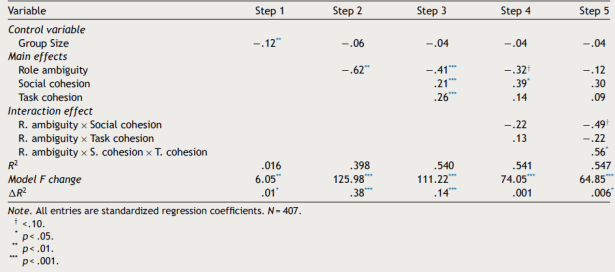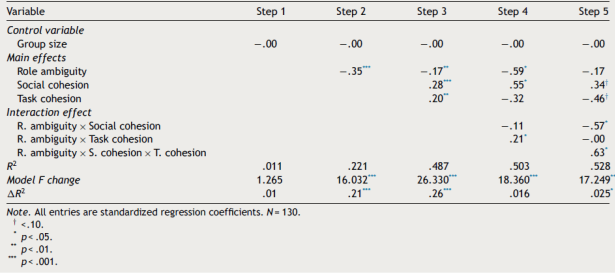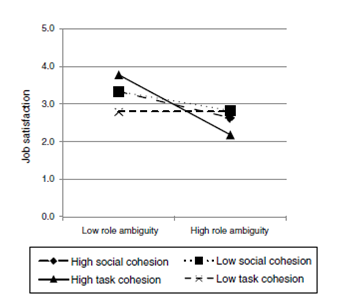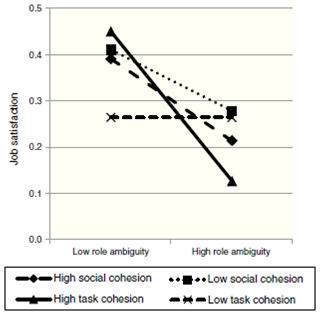The Demands-Resources, model first, theory now -JD-R- (Bakker & Demerouti, 2008, 2013), posits that working in highly demanding contexts where jobs require sustained physical and/or cognitive and emotional effort or skills caused by role ambiguity or time pressure, may produce over consumption of energy. These conditions could undermine employees' wellbeing, resulting in negative outcomes (e.g., lower levels of performance, job dissatisfaction, etc.). On the other hand, this theory indicates that job resources (physical, psychological, social and organizational facets of the job) may reduce job demands (i.e. buffering effect), can contribute to achieve work aims or can promote personal growth. Supportive peers, job control or group cohesion are examples of job resources.
The generalization of work groups in organizations as a management tool has provided an opportunity to study the JD-R theory since, work groups cannot only increase job' demands (e.g. task intensification, cognitive and social tasks) (), but also provide individ ual and group resources (e.g. peers support, more autonomy, task and social cohesion) (Treville & Antonakis, 2006). Thus, work groups could exert a double effect on workers as JD-R theory points out, depending on the balance between demands (ambiguous roles, etc.) and resources (group cohe sion, etc.).
Literature on work groups underlines that role ambigu ity (or absence thereof) and group cohesion are among the essential variables that contribute to successfully achieve goals (Carron, Eys, & Burke, 2007). Role ambiguity is a main demand in organizations subject to change (Antoniu, Davidson, & Cooper, 2003). Traditionally, blue-collar jobs tend to be simple, well structured, and stable over time; however, work groups seem to have altered this condition - thereby increasing job ambiguity (Kim, 2000).
In line with JD-R theory, this study seeks to test the effects of role ambiguity (demand) and group cohesion (resource) to explain job satisfaction in a multinational com pany from Mexico and Spain.
The Fifth European Working Conditions Survey (Parent-Thirion et al., 2012) reports that 67% of the European employees work in groups and 20% of the initiatives stored in the Bank of Best Practices of the Secretariat of Work and Social Prevention of Mexico (2013), are also based on work-groups. Moreover, the aforementioned work conditions survey includes poor social relationships and ambiguous expectations in the psychosocial risks' category (Parent-Thirion et al., 2012).
According to Tims, Bakker, and Derks (2013) when job resources increase, job satisfaction tends to increase too. One important social resource in order to deal with organi zational demands is group cohesion. With regard to direct relationships, cohesion is one of the most important deter minants of success in groups (Evans & Dion, 2012; Rico, Alcover, & Tabernero, 2011; Smith, Arthur, Callow, Hardy, & Williams, 2013). Positive relationships have consistently been found between cohesion and job satisfaction (Picazo, Gamero, Zornoza, & Peirö, 2015; Roulin, Mayor, & Banger, 2014) and recent meta-analyses also show the relevance of this construct to explain job results (Castano, Watts, & Tekleab, 2013). However, other studies find that not always does cohesion have a positive impact on job outcomes point ing to a more complex relationship between these two constructs (Ahronson & Cameron, 2007; Salas, Grossman, Hughes, & Coultas, 2015; Wise, 2014). JD-R theory's indirect effects could contribute to the explanation of these complex relationships, since group cohesion may exert a buffering role between job demands and job satisfaction (Jimmieson, McKimmie, Hannam, & Gallagher, 2010).
Cross-cultural studies - including data from Mexico and Spain - suggest maintaining the focus of research on the dif ferences amongst countries (Minkov, Blagoev, & Hofstede, 2013). Van de Vliert and Janssen (2002) compared forty-two countries and found that motivational methods may not be straightforwardly transferrable among regions and Ng, Sorensen, and Yim (2009) observe that the relation ship between satisfaction and performance is influenced by cultural values. JD-R theory also posits the relevance of analysing this subject, but there are not many studies addressing these differences. On exception is the research paper of Llorens, Bakker, Schaufeli, and Salanova (2006) , which posits that JD-R theory, could be applied to various national contexts. Even though no specific study comparing Mexico and Spain has been found, according to Hofstede's cultural dimensions (Hofstede, 1993), Mexico and Spain are closed in relation to uncertainty avoidance whereas when it comes to power distance, Mexico seems to be a more hierar chical society, so that subordinates could expect to be told what to do in their jobs. Similarly, both countries score dif ferently with regard to collectivism, Mexico scoring higher than Spain.
Document downloaded from http://www.elsevier.es, day 13/08/2017. This copy is for personal use. Any transmission of this document by any media or format is strictly prohibited.
Role ambiguity, group cohesion and job satisfaction
Accordingly, this paper tests the effects of role ambigu ity (demand) and group cohesion (resource) to explain job satisfaction in two samples from two countries, Mexico and Spain, working in a group-based multinational organization and also analyze whether between-country differences are salient. Moreover, this paper seeks to shed some light on the effects (direct and indirect) of the two dimensions of group cohesion (social and task) on job satisfaction, as these have not yet been clearly established.
Direct effects: role ambiguity and group cohesion
Job demands are physical, social or organizational aspects of the job that require sustained physical or mental effort, and are associated with certain physiological and psycholog ical costs (Demerouti, Bakker, Nachreiner, & Schaufeli, 2001; Bakker, Demerouti, & Verbeke, 2004; Bakker & Demerouti, 2014). Role ambiguity is referred to as the lack of clar ity about duties, objectives and responsibilities needed to fulfill one's role and is often experienced in technology, social and job changes. Blue-collar jobs used to be simple, well structured, and stable over time. However, working in groups objectively increases the number and type of tasks to be performed and these new demands may introduce uncertainty with regard to the expected responsibilities or performance levels. These changes have a negative effect on workers (Askenazy, 2001; Bauer, 2004; Brenner, Fairris, & Ruser, 2004) since ambiguity tends to produce negative emotions, attitudes and cognitions such as dissatisfaction, anxiety and exhaustion on workers.
Hypothesis 1. Role ambiguity is negatively related to job satisfaction.
Group cohesion and job satisfaction seem to establish a consistent relationship in various samples: bank employ ees (Kaya, Koc, & Topcu, 2010) or hospital nurses (Roulin et al., 2014). Traditionally, cohesion has been studied as a unitary construct derived from Festinger's definition, but several authors (de Jong, Curseu, & Leenders, 2014; Hausknecht, Trevor, & Howard, 2009; Picazo et al., 2015; Rico et al., 2011; Salas et al., 2015) have recently high lighted a two-dimensional approach dividing group cohesion into two categories: task cohesion and social cohesion. Meta-analyses on job performance (Castano et al., 2013; Chiocchio and Essiembre, 2009), focused their attention on these two dimensions as both have an adequate theoreti cal and empirical support. define cohesion as a twofold construct, which includes the shared commitment to the group's task and a shared attraction and mutual liking among group members. Evans and Dion (2012) meta-analysis also supports the idea that cohesive groups tend to get better results than non-cohesive groups, Castanno et al. (2013) reported significant relationships between both cohesion dimensions and job results and Picazo et al. (2015) found relationships between social cohesion and job satis faction at the end of the group task. However, other studies reported some inconsistencies between group cohesion and job satisfaction in industrial settings (Steinhardt, Dolbier, Gottlieb, &McCalister, 2003), in military samples (Ahronson & Cameron, 2007) or in nurses (Li, Mahrer, Klanstenfeld, & Gold, 2014), pointing to a more complex relationship between these constructs. As most research work reports a positive relationship between these variables, our second hypothesis is formulated in this direction.
Hypothesis 2. Task and social cohesion are positively related to job satisfaction.
Buffering effects: group cohesion
JD-R theory also raises a twofold moderating effect as job resources might buffer the negative influence of job demands on job attitudes and/or highly demanding jobs combine with high levels of job resources might result in higher levels of positive job attitudes (Bakker & Demerouti, 2008). Some support has been found for this effect on psy chological attitudes in various jobs (de Jonge, Le Blanc, Peeters, & Noordam, 2008). Social cohesion may exert a buffering role as this resource provides social support and social identity to group members (Jimmieson et al., 2010). Some authors confirmed the indirect effect of cohesion on the relationship between input and output variables (DeOrtentiis, Summers, Ammeter, Douglas, & Ferris, 2013; Li et al., 2014). Although the latter did not find any strong pos itive relationships between cohesion and satisfaction, they did regard cohesion as a ''protective factor'' against the negative effects of job demands on employees' attitudes (indirect effect).
Following other authors who have tested JD-R theory and three-way buffering effects (Jimmieson et al., 2010; Tuckey, Bakker, & Dollard, 2012; Van de Ven, Van den Tooren, & Vlerick, 2013), this paper analyses interactions between role ambiguity and the combination of both cohesion dimensions in order to test whether social and task cohesion interact among themselves and buffers the negative effect of role ambiguity on job satisfaction.
Consequently, role ambiguity is expected to be influ enced by the single or combined effect of social cohesion and task cohesion on its relationships with job satisfaction.
Hypothesis 3. Task and social cohesion may buffer the effect of role ambiguity on job satisfaction.
Method
Procedure
This study was conducted after the implementation of work groups in two industrial settings located in Mexico and Spain of the same company. Some members from our research team were involved in these processes as external con sultants at the design and implementation stages. Data collection was gathered at the end of formal group sessions several months after the new organization system was put in place.
Samples
Mexico
It consisted of 407 individuals distributed in groups from three up to 38 people. These groups manufactured and assembled engines or perform maintenance and quality tasks. Workers were all men - the majority were aged 27-36 (61%) - followed by those aged 18-26 (22%). In rela tion to their level of studies, the largest number (54%) had medium vocational training level, 30% had completed sec ondary school education and the rest did not report any formal certification.
Spain
The sample included 130 people divided in groups ranging from eight up to 25 people and manufactured engine parts. All were men, 55% aged 27-36, 19% were aged 18-26, and 14% were aged 37-46. With regard to the level of studies, the largest level achieved was high vocational training (61%) followed by medium vocational training (16%). 7% did not report any formal education.
Measures
Variables were measured using a Likert's scale-type ques tionnaire, ranging from 1, lowest level up to 5, highest level.
Role ambiguity
It was measured with Rizzo, House, and Lirtzman (1970) scale and consists of 7 items related to the extent to which workers are aware of their objectives, responsibilities and the level of uncertainty in their instructions (''I need to skip some rules in order to perform the assigned tasks'') (m = 2.12;f = 0.52; < = 0.82/m = 2.40; f = 0.63; ( = 0.76).
Group cohesion
Measured with a scale based on Hyatt and Ruddy (1997) paper and divided into two subscales:
Social cohesion. Three items about the strength of inter personal relationships among group members (''To what extent do you agree with the statement that there is a high level of trust between group members?'') (m = 3.42; ſ = 0.66; < = 0.70/m = 3.78; ſ = 0.64; ( = 0.81).
Task cohesion. Four items about shared perceptions on the tasks, decision making, etc. (''To what extent are your thoughts about your tasks distribution compatible with the thoughts of your group mates'') (m = 3.19; ſ = 0.67; < = 0.70/m = 3.76; ſ = 0.56; (= 0.70).
Job satisfaction. Eight items of the classic dimensions of job satisfaction asking for the satisfaction level with several facets of the job. (''To what extent are you satisfied with your current job?'') (m = 3.64; ſ = 0.51; ( = 0.74/m = 3.95; ſ = 0.48; ( = 0.81).
Control variable: Groups size. Group size could influ ence job attitudes as well as cohesion (m = 19.27; ſ = 10.09/m = 16.16; ſ = 6.67). This variable is one of the most frequently used as control variable and could be used to clar ify relationships between criteria and predictive variables (Schönrok, 2010).
Results
Means, standard deviations, correlations and internal con sistencies (Cronbach's alpha) are depicted in Tables 1 and 2.
In order to verify the hypotheses, several hierarchical regressions were carried out. Variables were introduced into the regression equation in various steps. In Step 1, group size was used as a control variable. In Steps 2 and 3, main effects of role ambiguity and social and task cohesion were entered. At Step 4, the interaction effects were introduced and at Step 5, the three-way interaction was added. Before entering the interaction effects, new variables were created (Cohen, West, & Aiken, 2003). The change in the amount of the variance explained (AR2) was studied in Steps 4 and 5 so as to assess the interactions.
In the Mexican sample (Table 3), all steps are signifi cant increasing the amount of variance explained, with the exception of Step 4. Step 1 accounts for 16% of the vari ance on job satisfaction (F=6.05, p< .01). Step 2 explains 39.8% (F= 125.98, p< .001) whereas Step 3 represents 54% (F =111.22, p<.001) and Step 5 explains 54.7% (F=64.85, p<.001).
Table 3 Moderated regression results of Role ambiguity × Social cohesion × Task cohesion on job satisfaction (Mexico).

In the Spanish sample (Table 4), all steps are also signifi cant except for Step 1 and only three of them increase the variance on job satisfaction. Step 2 explains 21% (F= 16.03, p< .001) while Step 3 accounts for 48.7% (F=26.33, p< .001). Step 5 predicts 52.8% (F=17.24, p< .001).
Table 4 Moderated regression results of Role ambiguity × Social cohesion × Task cohesion on job satisfaction (Spain).

Hierarchical regression shows a significant direct and negative relationship between job ambiguity and job satis faction in both samples (ß = -.62, p< .01; ß = -.35, p< .001), thus Hypothesis 1 has been confirmed. Direct effects of social and task cohesion on job satis faction are strongly established in Step 3 in both samples β =.21, p<.001; β =.26, p< .001/ β =.28, p<.001; β =.20, p< .01) thus, Hypothesis 2 could also be corroborated.
The comparison between Steps 2 and 3 in Mexico (Table 3) and Spain (Table 4) reveals that the amount of variance explained by these two Steps is different: role ambiguity (Step 2) explains 39% of the variance in the Mexican sam ple whereas it explains 22% in relation to the Spanish one. The increment of the variance explained by Step 3 (cohesion dimensions) is 14% in the Mexican sample whereas it reaches 26% in the Spanish one.
Two-way buffering effects are shown in Step 4 from both samples. However, these steps do not increase the vari ance explained. Nevertheless, two relations can be reported between role ambiguity and social cohesion (β = -.49, p < .10) in Mexico and between role ambiguity and task cohe sion (β = .21, p< .05) in Spain.
In both samples the increment of variance explained by this Step 5 is significant (∆R2 = .006, p < .05; ∆R2 = .025, p<.05) and a three-way interaction among role ambi guity, social cohesion and task cohesion to predict job satisfaction can be reported (β = .56, p<.05; β =.63, p < .05).
Figs. 1 and 2 show that at low levels of role ambiguity, task cohesion has a strong positive effect on job satisfaction in both samples, whereas at high levels of role ambigu ity, employees perceiving higher levels of task cohesion report lower levels of job satisfaction. At low levels of task cohesion, low or high role ambiguity does not exert any clear effect on job satisfaction in both samples. Addition ally, in the Mexican sample the level of job satisfaction at high or low levels of social cohesion is higher when role ambiguity is low. In the Spanish sample, the same effect is found, but the negative impact is more clearly observed when social cohesion is high. Results point to a moderating effect among these variables but not in the expected direction and buffering Hypothesis 3 cannot be accepted.

Figure 1 Three-way interaction effect between role ambigu ity, social cohesion and task cohesion to predict job satisfaction, Mexico.
Discussion
The aim of this article was to test JD-R theory to predict job satisfaction in two samples from two different countries working in the same multinational company organized in groups. The introduction of workgroups implied the redesign of jobs so that new and complex tasks were assigned and these new requirements could have incremented role ambi guity. On the other hand, groups developed processes and some estates emerged (i.e. cohesion) and both became resources (Schaufeli & Bakker, 2004). In our opinion, the main contribution of this paper is to study the effect of group cohesion (i.e. social and task) in more depth analyzing its direct and moderating influence on job satisfaction.
Results corroborated direct relationships as the JD-R theory suggested. Negative effect of role ambiguity was clear (Hypothesis 1): the more uncertainty there is about the tasks, goals and levels of performance, the less satis fied workers are. On the other hand, both task and social cohesion maintained a strong positive relationship with job satisfaction (Hypothesis 2).
It is important to underline that the negative effect of job ambiguity was more relevant in the Mexican sample. According to Hofstede (1993, 2015), and although Mexico and Spain obtain similar results with regard to uncertainty, differences in power distance are important. Due to that, Mexican employees might need more direction and clearer instructions from supervisors, whereas Spaniards would be able to assume responsibilities attached to a more decen tralized way of working. Apart from this divergent result, results remained similar, thus suggesting the salience role of organizational procedures over cultural differences.
With regard to the buffering effects, results showed that both types of cohesion interact with the effect of role ambi guity on job satisfaction, but these results did not support buffering effects (Hypothesis 3). Although highly cohesive groups may contribute to organizational objectives, under complex job conditions as highly ambiguous in our case cohesion could produce the opposite effect increasing job dissatisfaction or other negative work related attitudes as has been found in various studies (Ahronson & Cameron, 2007; Steinhardt et al., 2003; Westman, Bakker, Roziner, & Sonnentag, 2011; Wise, 2014).
Another explanation could be grounded on the level of effort put by the members of the group in order to develop social and more particularly task cohesion. Although group members may have developed a set of behaviors focused on the task, the assigned responsibilities may in fact be seen as so ambiguous that these strategies may not help them to fulfill their job demands. This explanation is consistent with the line of research on the role that norms could play when it comes to predict employee' intentions and behav iors within the organization (Ajzen, 1991; Castaneda, 2015). This could happen more clearly in the Mexican sample, since role ambiguity establishes a stronger relationship with job satisfaction.
This finding could also be explained based on the differ ent nature of the two dimensions of cohesion (social and task) combined in this study compare to other studies that combine homogeneous variables either both cognitive or both emotional (Tuckey et al., 2012; Van de Ven, van den Tooren, & Vlerick, 2013) and/or also be pointing to more complex relationships between variables (e.g. curvilinear relationships, other modulators, the effect of time), as Wise (2014) or Picazo et al. (2015) posit in their recent papers.
From an applied perspective, as job contexts and tasks requirements currently change more often due to techno logical and organizational innovation (i.e. role ambiguity might increase), a regular two-way flow of information (e.g. outcomes, behavior, difficulties in tasks' accomplishment, customers-clients needs) should be systematically carried out by organizations (Fruhen & Keith, 2014). As direct effects of cohesion on job satisfaction have been estab lished, companies should invest in some group activities (i.e. time to reflect on group tasks) so as to develop positive attitudes. Moreover, cohesion is characterized as an emer gent state (Cannon-Bowers & Bowers, 2011); hence more constant attention (i.e. monitoring) should be applied in order to keep the most adequate level of both cohesion' dimensions. Monitoring could be even more relevant since the buffering role of cohesion could also depend on job demands. Task and social cohesion seem to be needed in any kind of group, but the levels of both should be adjusted to the tasks and the context as it could exert a negative effect on relevant job attitudes - especially when com panies have to overcome uncertain conditions that could affect role demands. These findings should be taken into consideration to customize group training, group norms and other development and management activities in order to link them with the pace of change that companies need to undergo. Managers should not only learn at what levels of task and social cohesion their groups function best but also what types of group resources should not be implemented in order to improve certain job situations (i.e. role ambi guity). Moreover, companies should take into consideration divergences related to cultural differences.
From the cross-cultural perspective, these results are aligned with the studies that report the adequacy of JD-R theory in various countries (Llorens et al., 2006), although with some differences. However, more research would be needed in order to assess the antecedents of job satisfac tion across countries (Santamaria, de la Mata, Hansen, & Ruiz, 2010). Even though some divergences between Mex ico and Spain have been found in line with Hofstede's theory (1993; 2015), similarities are salient as working in the same company prevails over the country of origin. This salience of similarities could be grounded on the mecha nisms that multinational companies implement in order to reduce cultural differences.
The nature of this study meant the imposition of some constrains so as to be conducted in real working settings. Firstly, research studies should test these hypotheses at group level in similar samples. Salasetal. (2015) recommend a multilevel approach as it gives greater analysis flexibility with a longitudinal perspective. As cohesion is an inherently temporal construct, teams' development phases should be taken into account since the two dimensions of cohesion could be more salient depending on what the stage of the group currently is as Picazo et al. (2015) have confirmed. Secondly, further clarification on the relationship between role ambiguity, task and social cohesion and job satisfaction would be needed, as according to JD-R theory, our findings are in the unexpected direction (de Jong et al., 2014; Wise, 2014).
This paper confirms the relevance that direct effects of role ambiguity (demand) and task and social cohesion (resources) play to explain job satisfaction in two countries and in a based-groups organization. The negative moderat ing role of task and social cohesion combined has also been established in the relationship between the job demand and job satisfaction. This paper also introduces two innovations: the origin of the samples and the study of the combined effects of job resources of different nature in order to assess their effects on the relationship between demands and work attitudes. These results are relevant since orga nizations need to deal with increasing levels of ambiguity and complexity due to rapid change and although highly cohesive groups have been positively related to better job results, under certain circumstances these groups could be ineffective.

















